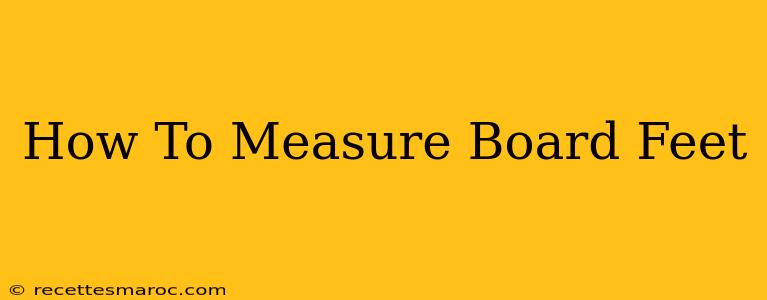Understanding how to measure board feet is crucial for anyone working with lumber, whether you're a seasoned carpenter or a DIY enthusiast. Accurate board foot calculations ensure you buy the right amount of wood for your project, avoiding costly waste or frustrating shortages. This guide will break down the process step-by-step, providing you with the knowledge and confidence to tackle your next woodworking project.
What is a Board Foot?
A board foot (often abbreviated as BF or bd ft) is a unit of lumber volume measurement. It represents a piece of wood that is 1 foot long, 1 foot wide, and 1 inch thick. This doesn't mean the board must be these exact dimensions; the calculation accounts for variations in length, width, and thickness.
How to Calculate Board Feet
The formula for calculating board feet is straightforward:
Board Feet = (Thickness in inches) x (Width in inches) x (Length in feet) / 12
Let's break down each component:
- Thickness: Measure the thickness of the board in inches. Remember to measure the actual thickness, not the nominal thickness (the size the lumber is commonly referred to as). For example, a "2x4" is actually closer to 1.5 inches thick and 3.5 inches wide.
- Width: Measure the width of the board in inches. Again, measure the actual width, not the nominal width.
- Length: Measure the length of the board in feet.
Example:
Let's say you have a board that measures 1 inch thick, 6 inches wide, and 8 feet long. The calculation would be:
(1 inch) x (6 inches) x (8 feet) / 12 = 4 board feet
Dealing with Fractional Measurements:
Often, you'll encounter boards with fractional measurements. Don't worry; simply use the decimal equivalent in your calculation. For instance, if a board is 1.5 inches thick, use 1.5 in the formula.
Common Mistakes to Avoid When Measuring Board Feet
- Using Nominal Dimensions: Always measure the actual dimensions of the lumber, not the nominal size.
- Incorrect Units: Ensure you're using inches for thickness and width, and feet for length, to get an accurate result. Mixing units will lead to incorrect calculations.
- Forgetting to Divide by 12: The most common mistake is forgetting the crucial division by 12 in the formula. This is essential to convert cubic inches into board feet.
Beyond the Basics: Calculating Board Feet for Irregular Shapes
While the formula above works for standard rectangular boards, calculating board feet for irregularly shaped lumber requires a bit more work. You might need to break down the irregular shape into smaller, more manageable rectangular sections and calculate the board feet for each section individually, then add them together. For extremely complex shapes, using a professional's expertise may be advisable.
Tips for Accurate Measurement
- Use a reliable measuring tape: Invest in a quality measuring tape for precise measurements.
- Double-check your measurements: Always double-check your measurements to ensure accuracy before calculating.
- Account for Waste: When planning a project, remember to add extra board feet to account for cuts, mistakes, and scrap. A 10-15% buffer is often recommended.
Mastering Board Foot Measurement: A Key Skill for Woodworkers
Understanding how to accurately measure board feet is an essential skill for anyone working with wood. By following the steps outlined above and avoiding common mistakes, you can confidently calculate the amount of lumber needed for your project, saving time, money, and frustration. Mastering this skill will elevate your woodworking projects from simple DIY to truly professional results.

